
The Vitaceae are a family of flowering plants, with 14 genera and around 910 known species, including common plants such as grapevines and Virginia creeper. The family name is derived from the genus Vitis.

Larrea tridentata, called creosote bush and greasewood as a plant, chaparral as a medicinal herb, and gobernadora in Mexico, due to its ability to secure more water by inhibiting the growth of nearby plants. In Sonora, it is more commonly called hediondilla; Spanish hediondo = "smelly".
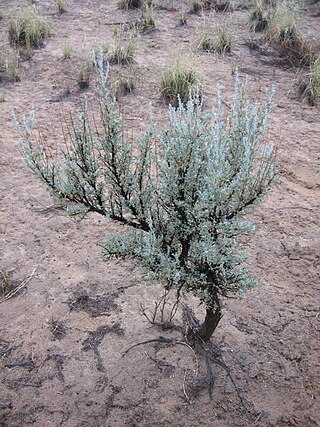
Artemisia tridentata, commonly called big sagebrush, Great Basin sagebrush or (locally) simply sagebrush, is an aromatic shrub from the family Asteraceae, which grows in arid and semi-arid conditions, throughout a range of cold desert, steppe, and mountain habitats in the Intermountain West of North America. The vernacular name "sagebrush" is also used for several related members of the genus Artemisia, such as California sagebrush.

Purshia tridentata, with the common name bitterbrush, is a shrub in the genus Purshia of the family Rosaceae. It is native to mountainous areas of western North America.

Shrub-steppe is a type of low-rainfall natural grassland. While arid, shrub-steppes have sufficient moisture to support a cover of perennial grasses or shrubs, a feature which distinguishes them from deserts.

Banksia tridentata, commonly known as yellow honeypot, is a low-growing shrub that is endemic to the southwest of Western Australia. It has narrow egg-shaped leaves with a sharp point on the tip, greenish yellow flowers in heads of between 85 and 125, and elliptical to egg-shaped follicles.

Sibbaldia tridentata is a species in the plant family Rosaceae. Its synonyms include the illegitimate name Sibbaldia retusa and Sibbaldiopsis tridentata. Under the latter name, it has been treated as the only species in the genus Sibbaldiopsis. Its English names include three-toothed cinquefoil, shrubby fivefingers, and wineleaf.
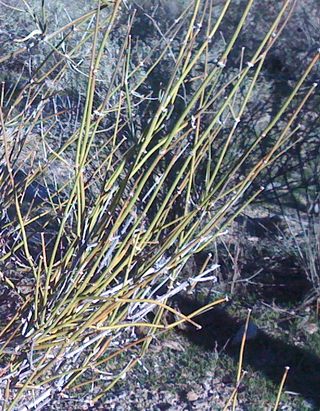
Ephedra fasciculata is a species of plant in the Ephedraceae family. Common names are Arizona ephedra, Arizona jointfir, and desert Mormon-tea.
Metrioxenini (metrioxenines) are a tribe of belids, primitive weevils of the family Belidae, containing about 30 species. They are only found in two widely separated areas, Southeast Asia extending to Indonesia, and South Africa. In the Paleogene, they were found at least in North America and Europe also, occurring perhaps across the entire Northern Hemisphere.

Sagebrush is the common name of several woody and herbaceous species of plants in the genus Artemisia. The best known sagebrush is the shrub Artemisia tridentata. Sagebrushes are native to the North American west.

Neotinea tridentata, the three-toothed orchid, is a species of orchid found in southern Europe from Spain to Turkey; northwards to the Crimea, Poland and Germany. This orchid favours grassy places, woodland, scrub and maquis.
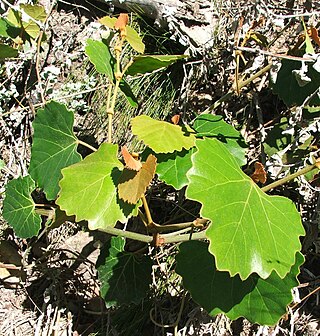
Rhoicissus is an Afrotropical plant genus in the grape family Vitaceae and subfamily Vitoideae. There are between nine and twenty-two accepted species.

Rhoicissus rhomboidea is a climbing plant in the family Vitaceae, commonly known as the glossy forest grape. It is found in the eastern forests of southern Africa. The species was first described in 1859, treated under Cissus.
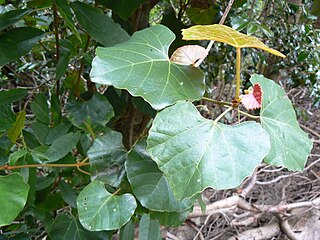
Rhoicissus tomentosa is a vigorous, evergreen vine that is indigenous to the afro-montane forests of southern Africa. It is increasingly popular as an ornamental creeper in gardens, and it has a wide range of uses in traditional medicine.
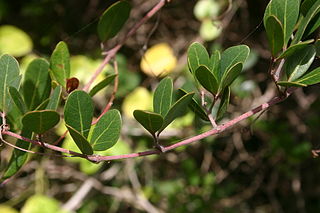
Rhoicissus digitata is a vigorous, evergreen vine that is indigenous to southern Africa. It is increasingly popular as an ornamental creeper in gardens, and it has a wide range of uses in traditional medicine.

Purshia glandulosa is a species of flowering plant in the rose family known by the common names antelope bitterbrush, desert bitterbrush, Mojave antelope brush, and cliff-rose.

Holocacista is a genus of moths of the family Heliozelidae. It was described by Walsingham and Durrant in 1909.

Iris tridentata is a species in the genus Iris, it is also in the subgenus Limniris and in the series Tripetalae. It is a rhizomatous perennial, from the Southeastern United States. It has a cord-like rhizome, bright green leaves, long stem and fragrant flowers in spring in shades of blue.
Hibbertia tridentata is a species of flowering plant in the family Dilleniaceae and is only known from a single population in Arnhem Land in the Northern Territory. It is a shrub with a few wiry branches, egg-shaped to triangular leaves with the narrower end towards the base, and yellow flowers usually arranged singly in leaf axils with eighteen to twenty stamens arranged around two densely scaly carpels.


















